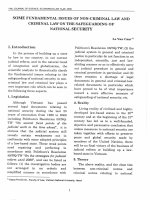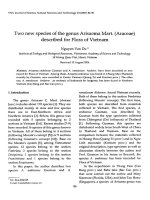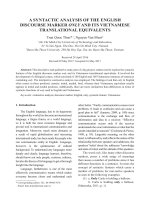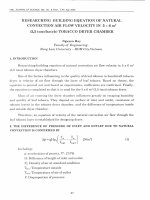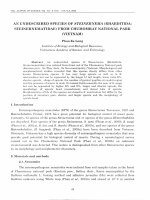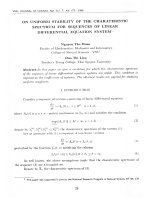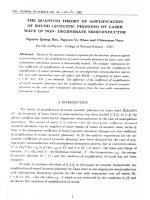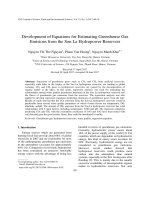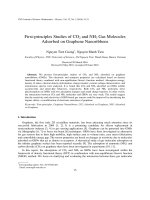DSpace at VNU: Understanding Complex Landscape of Memory, Commemoration, and Culture with Location-based Technology
Bạn đang xem bản rút gọn của tài liệu. Xem và tải ngay bản đầy đủ của tài liệu tại đây (692.08 KB, 9 trang )
VNU Journal of Science, Vol. 32, No. 1S (2016) 149-157
Understanding Complex Landscape of Memory,
Commemoration, and Culture with
Location-based Technology
Andy Mink1,*, Chris Bunin2, Matt Dunlevy3, Christian Lentz4
1
National Humanitites Center
Albermarle County Public School
3
Radford University
4
University of North Carolina – Chapel Hill
2
Received 06 October 2016
Revised 18 October 2016; Accepted 28 November 2016
Abstract: Current and emerging technologies provide increasing levels of situation- and location
based information. It is critical in an increasingly information- and knowledge-based society that
visitors, citizens, and students are prepared to access, think critically about, and process that
information. This panel will illustrate a series of proof of concept projects that leverage the
emerging technologies of location-based technologies to enhance the educational experience at
sites in the United States and Europe. This projects leverage technology to not only access
information, but to build materials for formal (classroom-based) as well as informal (site-based)
learning. These materials have value for teachers and students in classrooms across America, and
they also be important additions to the on-site and at-memorial visitor experience.
Keywords: Memory; commemoration; culture; location-based technology.
1. Moderator Andy Mink Will frame the
session with a detailed summary of educational
trends in the digital age with a particular
emphasis1on memory and commemoration. As
access to big data increases, schools and
universities must provide new opportunities for
student investigation, inquiry, and production.
The National Humanities Center is the only
research center in the world dedicated to the
humanities, and these emerging technological
tools provide a powerful means to
accomplishing a greater understanding of
cultural landscapes.
2. Chris Bunin Will feature the use of
geospatial technologies allows the interactions
of place, space, time, and scale to be more
obvious to teachers and students. Often there is
an over-emphasis on the chronology of
historical events and without a strong
consideration for their connections to
geography. We expect these technologies to
raise the critical ability to answer not only the
important of “where?” but also “why, there?”
In 2012, ESRI launched ArcGIS Online
(AGO) which allows users to upload,
symbolize, filter, and display data sets in real
time. Unlike other Web mapping tools, AGO
fosters interdisciplinary connections because
the user is allowed to collect, upload, and
_______
*
Corresponding author
Email:
149
149
150
A.Mink et al. / VNU Journal of Science, Vol. 32, No. 1S (2016) 149-157
interact with the data in real time in the cloud.
Most other geospatial tools limit the user's
access to the data, which in turn limits the
inquiry process. The possibilities for classroom
application are tremendous. Rather than writing
a research paper on a historical event, students
can interrogate the sources and materials (e.g.,
publications, historic maps, primary source
accounts), geo-tag the information, and present
their findings in the form of an interactive map.
Activities and lessons allow students to utilize
AGO to translate digital archives into
interactive maps that visualize and explain
personal, political, and cultural narratives from
I
a complex landscape.
Of course, due to time constraints some
teachers may shy away from such an immersive
learning experience. To address this need, we
will also create classroom materials that are
ready to go in the form of a series of Story
Maps based on ABMC materials and
resources. Story Maps use geography as a
means to organize and present information.
They tell the story of a place, event, issue,
trend, or pattern in a spatial context. These
interactive maps also contain other rich content
like photos, video, and audio that are basic and
intuitive to the user.
These digital maps will provide access to
the narrative stories of each individual and each
site featured in this project. We will share
I
several project examples, including the MeuseArgonne region of World War I, the American
Civil War, and the Transatlantic Slave Trade
A.Mink et al. / VNU Journal of Science, Vol. 32, No. 1S (2016) 149-157
151
i
3. Matt Dunleavy Will focus on the use of
Augmented Reality, which by its nature is sitebased, adding content to the environment in
which the user currently resides. FreshAiR
will used to add on-site, location-based or
augmented reality (AR) tour experiences that
will supplement currently offered tours, bolster
self-guided tour options, and increase overall
visitors’ understanding and appreciation for the
experience, service and sacrifice of specific sites.
FreshAiR is a lightweight mobile app
developed at Radford University that allows
digital assets to be geo-tagged to a location.
These assets can be in the form of text, image,
audio, or video, and the device allows for
interaction with these materials while on a
walking tour of a landscape or site.
/>
FreshAiR provides two clear applications
that will benefit this project as well as inform
all NCA site-management initiatives:
Browser-based Editor: NHC can create
custom AR experiences using our intuitive
editing website, which enables them to embed
an interactive layer of digital information into
the grounds at and around the designated sites.
Smartphone-based App: The story-based,
participatory FreshAiR tours are experienced
on a smartphone and use location-based
technologies (i.e., GPS and compass) to present
location-specific information to the visitor as
they explore the grounds. As the visitor walks
around the sites, a map on their phone displays
digital objects on the smartphone display. As
users explore their environment, the
FreshAiR software triggers video, audio, text,
and images, which provide location-specific
information as well as narrative, navigation, and
collaboration cues.
FreshAiR will be used at the sites to
create customized historic tours. Visitors can
experience the historic grounds at their own
pace and with gain a deeper understanding of
the men who fought and died during conflict.
For example, as a visitor opens FreshAiR on
their smart phone at the Manila American
Cemetery, they would be prompted to choose a
tour in either English or Tagalog, a language
spoken in the Philippines. The visitor would
then see an overhead map of the cemetery with
specific areas designated with points of interest.
As the visitor walked towards one of these
digital markers, their location would trigger
152
A.Mink et al. / VNU Journal of Science, Vol. 32, No. 1S (2016) 149-157
content (e.g., text, audio, video) that would
illuminate a specific story or experience. If a
visitor were walking past graves of men who
died in the Bataan Death March, a video would
play explaining the history of this march and
prompting the visitor to find a specific grave
site of an individual. The map on their phone
would then guide the visitor to this gravesite at
which point another video would be triggered
providing a biographical sketch of the man
highlighting his life before and during the war
while emphasizing how his sacrifice
contributed to the War effort and eventual
victory. The entire area could be populated with
these stories that visitors could explore for
hours profoundly illuminating the individual
experiences while honoring their collective sacrifice.
While this application implies that the user
must visit the site to employ the content and
learning, FreshAiR creates opportunities in two
key ways:
The ability to continually refresh
mobile content is a return driver for visitors
The ability to display content from a
distance means that educators can bring the site
experience to any school grounds in the world
and embed that content on a local site
After consulting with the NHC, reviewing
digital resources, and reviewing recent literature
on mobile, location-based AR design, the
following design elements were identified as
requirements for these experiences:
1) Immerse the visitor in a compelling and
powerful narrative with elements of mission,
purpose, exploration and interactivity.
2) Prompts meaningful observation and
interaction with the physical environment.
3) Beyond what they could observe or read.
4) Deeper understanding of the history.
5) Presents material with rich multimedia
whenever possible.
6) Presents historically accurate accompanied
with biographical information on individuals
who are memorialized at the respective sites.
7) Maintains a sensitive and respectful
approach to the community, their families and
the site.
8) Provides a linear, individual mobile
learning experience that also allows for
opportunities for family, class, or friend
collaboration.
9) Presents the visitors with problem
solving activities that result in increased
retention of historical facts.
10) Enables host to build upon or extend the
initial Realities or experiences with a serial or
sequel approach that serves as a return driver.
11) Incorporates best practices from
augmented and alternate reality learning and
gaming (e.g., scoring mechanisms, role-based
participatory story-lines, etc.).
12) Aligns with research on intrinsic
motivation. In other words, it incorporates
elements of the following taxonomy: challenge,
fantasy, curiosity, control, cooperation,
competition, and recognition [1].
Platform: FreshAiR works on the two major
smartphone platforms: Apple’s iOS and
Google’s Android. By focusing on these two
operating systems, FreshAiR will work on 90%
of the smartphones on the market [2].
Visual Style: The visual style will be largely
dictated by the aesthetic richness of the
platform, FreshAiR, which is limited. However,
all media and some formatting (via HTML) can
be tailored to match the time-period and style of
the game and organization (e.g., matching the
colors with the color-schemes of the website).
General Activity Structure at the Sites
The basic structure of the experience will
follow these steps:
Navigate to location (figure 1)
Receive
site-specific historical
and
biographical information about the site
delivered through a narrative (figure 2).
Complete a challenge (e.g., comprehension
question or other assessment) requiring the
application of the information presented in the
previous step.
Receive an accomplishment or achievement
item (e.g., History Badge) (figure 3).
Receive prompt to go to next location.
On-Site Sample Experience Storyboard –
On Site at Manila American Cemetery
A.Mink et al. / VNU Journal of Science, Vol. 32, No. 1S (2016) 149-157
Fig. 1. Navigate to a location 1.
Fig. 3. Receive an accomplishment item.
Note: “Screen content” is what the visitor
will see, read and hear. Some of the sample
content was drawn from the Manila American
The “Notes” column is for the designers to explain
153
Fig. 2. Receive location 1 historical information.
Fig. 4. Receive prompt to proceed to location 2.
the structure and rationale for the screen
content. Cemetery website for illustrative purposes.
Once art and graphics are developed, they will
be placed in the “Screen Content” area as well.
154
A.Mink et al. / VNU Journal of Science, Vol. 32, No. 1S (2016) 149-157
Location 1: Memorial Entrance [3]
Screen Content
Screen 1 (Welcome): Welcome to the tour of the
Manila American Cemetery. 17,202 American and
Philippine military who died in New Guinea, the
Philippines, and other islands of the Southwest Pacific
Area are buried in this cemetery. Most of these men
lost their lives in the epic defense of the Philippines
and the East Indies in 1941 and 1942 or the victorious
return of the American forces through the vast islands
chain. The area covers 152 acres making it the largest
American Cemetery built by the American Battle
Monument Commission. This mobile self-guided tour
of the grounds will take approximately 30 minutes.
Click ‘Done’ in the upper right hand corner and look
on your map to find the Chapel, your next location.
Then walk towards the Chapel to receive more
information.
Notes
Media: As visitors enter the Cemetery, the guards
could handout out information making visitors
aware of the mobile tour, and prompt them to
download FreshAiR. After downloading and
opening FreshAiR, the visitor will immediately see
the mobile location-based tour of the grounds.
Visitors would then be greeted with Screen 1. This
introduction could be delivered via audio, video
(e.g., ABMC Manila American Cemetery Video),
text and pictures, or both to make it as accessible as
possible.
Narrative/mechanics: The player is introduced to
purpose of the tour and the general history of the
site. The player is also introduced to the basic
device functions.
Time at Welcome: 1-2 minutes: Estimate Total Experience Time: 1-2 minutes
Visitor physically moves from entrance of Cemetery to the Chapel (3-5 minutes). When the visitor comes
within approximately 30 feet of the chapel, the following content will be automatically triggered on their
phones.
Screen 2 (Chapel): Standing before you is the Chapel. Media: See above.
This chapel provides visitors a place to pray and Narrative/mechanics: The visitor is prompted to
meditate on the lives and sacrifice of the men buried at observe and reflect upon their environment. In this
this sacred site. Look above the doorway of the chapel. example, a comprehension question is posed, which
Do you see the relief sculpture? Look at the sculpture requires the visitor to more deeply engage with the
and reflect upon what this may symbolize.
meaning of the sculpture engraved above the
entrance to the chapel. In similar fashion, the entire
After reflecting upon the symbolism of this sculpture, grounds could be embedded with observation and
click ‘Done’ in the upper right hand corner to test how interaction prompts to invite the visitors to learn
well you understand this symbol…
about and reflect upon the memorial and
surrounding graves.
Screen 3 (St George and the Dragon Media: Text
Narrative/mechanics: The visitor is periodically
Comprehension Question)
What could the sculpture symbolize? (multiple choice)
asked comprehension questions that serve to invite
Click ‘Done’ in the upper right hand corner and look interaction with and reflection upon the
on your map to find the grave of a Medal of Honor surrounding environment. In this case, the visitor is
recipient, Private First Class Benjamin George. Then asked a question about the sculpture of St. George
walk towards the Private George’s grave to learn more and the Dragon in hopes that they would grasp the
about this hero’s story and sacrifice.
symbolism of good versus evil as well as sacrifice.
Comprehension questions can be embedded
throughout the area.
Time at Chapel: 2-4 minutes: Estimate Total Experience Time: 6-11 minutes
Visitor physically moves from the Chapel (3-5 minutes) to the gravesite of Private George. When the visitor
comes within approximately 30 feet of the grave (Plot B Row 7 Grave 156), the following content will be
automatically triggered on their phones.
Screen 3: George Benjamin, Jr., Private First Class
Media: This story of Private
U.S. Army, Killed in Action December 21, 1944 on Leyte Island, George could be delivered via
Philippines
audio, video, text and pictures.
A.Mink et al. / VNU Journal of Science, Vol. 32, No. 1S (2016) 149-157
155
Medal of Honor Recipient
Grave: Plot B Row 7 Grave 156
Narrative/mechanics: The idea
“He was a radio operator, advancing in the would be to bring the men to
rear of his company as it engaged a well- life by sharing their stories both
defended Japanese strong point holding up before and during the war. In
the progress of the entire battalion. When a this case, Private George was a
rifle platoon supporting a light tank medal of honor recipient and his
hesitated in its advance, he voluntarily and citation is quoted here along
with utter disregard for personal safety left with his photograph. One
his comparatively secure position and ran possibility is to have a relative
across bullet-whipped terrain to the tank, (e.g., a great granddaughter) of
waving and shouting to the men of the the highlighted men to read the
platoon to follow. Carrying his bulky radio citation on video and then
and armed only with a pistol, he fearlessly embed this video into the
penetrated intense machinegun and rifle fire to the enemy position, where location. This juxtaposition of
he killed 1 of the enemy in a foxhole and moved on to annihilate the crew the living with the dead could
of a light machinegun. Heedless of the terrific fire now concentrated on emphasize the sacrifice these
him, he continued to spearhead the assault, killing 2 more of the enemy men made and celebrate the
and exhorting the other men to advance, until he fell mortally wounded. freedom and life their deaths’
After being evacuated to an aid station, his first thought was still of the continues to provide to this day.
American advance. Overcoming great pain he called for the battalion
operations officer to report the location of enemy weapons and valuable
tactical information he had secured in his heroic charge. The unwavering
courage, the unswerving devotion to the task at hand, the aggressive
leadership of Pfc. Benjamin were a source of great and lasting inspiration
to his comrades and were to a great extent responsible for the success of
the battalion's mission.”[4]
Time at Private George’s grave: 2-4 minutes: Estimate Total Experience Time: 8-15 minutes
Visitor continues to move throughout the
cemetery being guided and taught about the
stories of heroism and sacrifice that surround them.
Off-Site Sample Experience Description
and Literature Review – Any School on the
Globe. In addition, FreshAiR can be leveraged
to provide off-site, mobile location-based
experiences for students who cannot visit the
actual sites. These off-site FreshAiR
experiences will in effect bring the stories of
this historical period and of the individual men
who served to the school grounds. Rather than
the students going to the site, the site would
come to the students. The scenario below
provides an example:
When the bell rings, the eager eighth-grade
students pour out of the building with their cell
phones and gather around their history teacher.
The teacher explains that the day’s lesson will
require them to explore the experience of
soldiers and their families during World War II.
As the students exchange quizzical looks, one of
them asks, “Are we going on a field trip to a
museum?” “No,” the teacher responds, “the
museum is coming to us.” She instructs them to
turn on their GPS-enabled smartphones to
begin the lesson. As they do so, digital
characters and items begin to appear on their
smartphone screens. Running across the school
grounds, the students meet soldiers and families
who soldiers deployed. Nearing the water
fountain, a video file of the Bataan Death
March plays on the students’ phones. A letter
written by a mother to her son on the eve of the
invasion of Guadalcanal is revealed behind the
gymnasium. Across the once-familiar school
grounds, students work together to discover
multiple inter-connected stories leading them
down the path of historical inquiry-based
learning, collaborative problem solving, and
156
A.Mink et al. / VNU Journal of Science, Vol. 32, No. 1S (2016) 149-157
When students come within approximately 20
feet of these digital artifacts, the AR and GPS
software triggers video, audio, and text files,
which provide academic and collaborative
problem solving challenges as well as narrative,
navigation, and collaboration cues.
Figure A. Students exploring environment.
Figure C. Overhead view.
Figure B. Students experiencing embedded stories.
appreciation for the sacrifice endured by the
military and the home front during World War II.
While the scenario described above may
seem fantastic, this instructional model is not
only possible, it has been implemented
numerous times by the FreshAiR team and
collaborating educators. The story-based,
mobile augmented reality (AR) lessons
developed by the FreshAiR team are
experienced on smartphones (Figure A) and use
GPS technology to correlate the students’ real
world location to digital artifacts embedded
within school sites.
As the students walk and run around their
school playground or sports fields (Figure B), a
map on their handheld displays digital objects
and virtual people who exist in an AR world
superimposed on real space (Figures C & D).
Figure D. Live view.
This type of interactive, mobile learning
superimposes a layer of digital resources over a
real physical environment, augmenting
students’ experiences by providing interactive,
situated, collaborative and physical learning
activities as well as narrative, navigation, and
collaboration cues. This type of interactive,
mobile learning superimposes a layer of digital
resources over a real physical environment,
augmenting students’ experiences by providing
interactive, situated, collaborative and physical
learning activities as well as narrative,
navigation, and collaboration cues.
A.Mink et al. / VNU Journal of Science, Vol. 32, No. 1S (2016) 149-157
This type of interactive, mobile learning
superimposes a layer of digital resources over a
real physical environment, augmenting students’
experiences by providing interactive, situated,
collaborative and physical learning activities.
4. Dr. Christian Lentz Will conclude by
providing specific ways that these locationbased and mobile-based tools can be a greater
asset to the study of Vietnam and its
relationship with the United States. This
conclusion will also share details of the new
TransPacific Teacher Scholars Program that has
been funded by FIRST and will be launched in
2017.
157
References
[1] Malone, T. W., & Lepper, M. R. (1987). Making
learning fun: A taxonomy of intrinsic
motivations for learning. In R. E. Snow & M. J.
Farr (Eds.), Aptitude, Learning and Instruction
III: Conative and affective process analyses (pp.
223-253). Hilsdale, NJ: Erlbaum. (Note: Cited
by 1362).
[2] />[3] />tions/Manila_Booklet.pdf
[4] />
Hiểu rõ bối cảnh phức tạp giữa trí nhớ, kỷ niệm và văn hóa
với công nghệ dựa vào vị trí
Andy Mink1, Chris Bunin2, Matt Dunlevy3, Christian Lentz4
1
Trung tâm Nhân chủng học Quốc gia
2
Trường công lập tỉnh Albermarle
3
Đại học Radford
4
Đại học North Carolina - Chapel Hill
Tóm tắt: Công nghệ mới hiện nay cung cấp nhiều cấp độ thông tin dựa trên tình hình và vị trí.
Điều này rất quan trọng trong một xã hội ngày càng dựa trên tri thức và thông tin mà những người tìm
hiểu thông tin, các công dân, và học sinh đều được chuẩn bị để tiếp cận, cân nhắc kỹ càng, và xử lý
các thông tin đó. Nhóm nghiên cứu sẽ minh họa một loạt các minh chứng về các dự án tận dụng kỹ
thuật mới của công nghệ dựa vào vị trí để gia tăng trải nghiệm trong giáo dục tại một số website ở Hoa
Kỳ và Châu Âu. Điều này không chỉ nâng tầm công nghệ để tiếp cận thông tin, mà còn xây dựng cơ sở
tài liệu cho việc học chính quy (trên lớp) và cả không chính quy (trực tuyến). Những tài liệu này có giá
trị cho nhiều giáo viên và học sinh các lớp trên toàn Hoa Kỳ, và điều này cũng là bổ trợ quan trọng
cho các trang web và trải nghiệm để lại dấu ấn cho những ngýời quan tâm.
Từ khóa: trí nhớ; kỷ niệm; văn hóa; công nghệ dựa vào vị trí.
